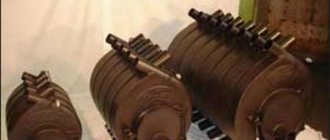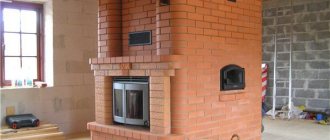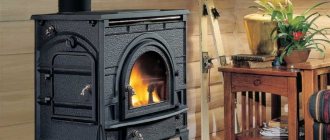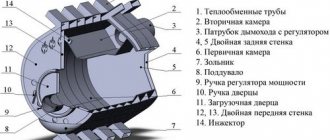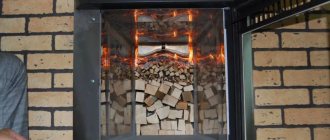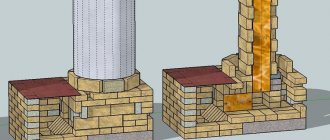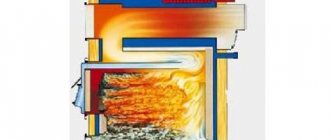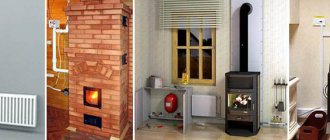DIY oven
What else will you need besides a metal barrel?
- Sheets of iron 4-5 mm thick.
- Pipe with a diameter of 100 mm.
- A grate is better prepared, although you can make it yourself, for example, from a corner and wire.
- Asbestos cord.
Barrel construction
Now the sequence of assembly work:
The lid of the barrel is cut out with an allowance of 40-50 mm. A hole is made in the center of it, slightly larger than the diameter of the pipe 100 mm. A rectangular hole is cut out at the bottom of the barrel for the firebox. Fuel will be loaded through it. A smaller rectangular hole is made just below for the blower. From the inside of the barrel, between the firebox and the ash pit, wire guides are welded onto which the grate will be laid. A hole for the chimney is cut in the upper part on the side. A pipe with a diameter of 100 mm and a length of 20-40 cm is immediately welded to it. Now a pancake with a diameter slightly less than the diameter of the barrel is cut out of a metal sheet. A hole is made in the center of the pancake and a pipe with a diameter of 100 mm is welded to it. The length of the pipe should be 20-50 cm greater than the height of the barrel. Rectangles 50-80 mm wide are cut out of the same sheet, but their length should be equal to the distance from the edge of the pancake to the edge of the through hole in the center. These pieces are evenly welded in a circle with an edge on the back side of the welded pipe. This node is called a press. With its help, the fuel will be pressed down so as not to create a large space for the combustion zone. Now we need to carry out partial assembly. That is, a grate is installed and a press is lowered from above. A lid is placed on it so that the press pipe fits into the hole in the lid. Now the lid is welded to the stove body around the entire perimeter
Here it is important to weld the seam very tightly. An asbestos cord must be placed in the gap between the protruding pipe and the hole in the lid; it will become a barrier to smoke and carbon monoxide. The door is hung on the opening of the firebox. The gate is installed on the blower.
Everything is ready, all that remains is to install the stove at its destination and attach the chimney to it
Under such a unit, a strong and fire-resistant base must be poured, this is important
Fuel loading
Now to the question, how to add fuel? For this you will definitely need an assistant. He will lift the press by the protruding pipe. You need to lift it as high as possible to completely open the combustion chamber. The fuel is packed tightly with minimal space between its parts. The less air inside the firebox, the longer the pyrolysis process takes.
Not everyone probably understood why the pipe that was welded to the press was needed. This is a special channel through which fresh air will be supplied to the fuel combustion zone. And the ribs welded at the bottom will create the necessary space for air to penetrate inside, plus they add additional weight to the press.
This is one of the models of long-burning stoves that you can make with your own hands from a two-hundred-liter metal barrel. Let's face it, the option is not the most difficult, but not the most beautiful either. No one will install a barrel in a living space, so such stoves are most often installed in utility rooms for office purposes. For example, in garages, workshops, greenhouses, and so on. Although some summer residents install them inside the main building, enriching the structure with additional elements. For example, you can install a decorative screen in front of the stove, or line it with brick. Anyone who wants to will find options to make the stove beautiful.
Features of operation
When operating such devices, you must adhere to several basic safety rules:
- It is imperative to insulate the pipe through which the exhaust gas exits. The insulation must be made of non-combustible material;
- you need to install the stove as intended by the manufacturer, without deviating from the instructions;
- all walls must be protected by cladding made of metal or other materials;
- you should carefully add fuel;
- It is better to surround the structure with protective materials that are resistant to fire.
Construction of gas generator type furnaces
Gas-generating water heating furnaces do not contain a firebox, like conventional models. The design of all pyrolysis furnaces is very complicated. A wood-burning gas generator stove consists of a pre-gasification chamber - firewood is directly placed into it, and a combustion chamber - where the fuel is processed into heat. Gases from the gasification chamber enter the combustion chamber through the nozzle due to the action of the fan. (See also: Long-burning heating stove)
Please consider the following factors when assembling and using:
- The humidity of the firewood used should not exceed 20%. This is a fairly low indicator, which characterizes the firewood as very dry. During normal storage, firewood can dry to a level of at least 30-40%, and to achieve the above figure, you will need to use a heat gun or another option for drying firewood.
The connection between the chimney and the outlet damper should be very easy to disassemble. The fact is that with increased humidity of the wood, condensation will form, containing tree resin. This same condensate, passing through the chimney, will be able to clog it - in this case, resin-like clots are formed that cannot be soaked with water and are not subject to combustion. They are quite difficult to remove from the chimney.
Which stove is better to choose for your home?
For home use, the best ovens are those that have sufficiently high power and are compact. This solution will be good for rooms of any size, because due to its high efficiency, such a stove can quickly heat a room to high temperatures.
When choosing an option for heating a home, you should also pay attention to the safety of the design, because such stoves are mainly used for rooms in which people rarely visit. However, a design that has protection and high energy efficiency is suitable for home use.
Criterias of choice
When choosing this equipment, you should be guided by the standard parameters that are taken into account when purchasing heating stoves. Among them:
- power and productivity that a gas generator furnace has. It should be calculated based on your own heating needs and the size of the room that will be heated with its help;
- price of installing a chimney system;
- design dimensions, which may not coincide with power indicators, because compact fuel stoves with the ability to add it during the combustion process do not take up much space and with such characteristics have high energy efficiency indicators;
- the approximate fuel consumption of a given stove model is also an important parameter that can be calculated or obtained from the manufacturer, who provides customers with such information;
- the ability to add additional air ducts to this design;
- the material from which the stove is made and its thickness. If it is steel or other metals, then it is imperative that the walls be at least 3 mm, and on surfaces that come into contact with fire, at least 4 mm, otherwise the structure may be deformed due to temperature changes.
Review of the best models
- Kochegar 70. It weighs 36 kg and can heat a room with a volume of 80 cubic meters. It has a long-burning mode with the ability to regulate the gas supply to the combustion chamber. Height 45 cm, width 50 and depth 36 cm, so the model is small in size.
- Vesuvius AOGT 00 100 . This model is also intended for installation in homes or cottages, because it has an attractive design. It heats up to 100 cubic meters. m. room, weighs 50 kg and is installed near the wall. Also has a convenient ash drawer.
- Gori Yasno Viking-150. This is a more powerful stove model than the ones described above. According to its characteristics, it is suitable for heating a large room of 150 cubic meters. There is a long-term combustion mode and the material used here is steel.
The principle of gas generation. Scheme of operation of a long-burning furnace
The operation of gas generator furnaces is based on the principle of wood gasification - a fuel combustion mode in which pyrolysis gas is formed.
Gas generation is achieved by burning fuel in smoldering mode under conditions of oxygen deficiency. The efficiency of such a heating unit increases several times in comparison with classic combustion furnaces.
The combustion mode is regulated by supplying air to the firebox. Heat is transferred to the heated room through heat exchange surfaces.
Let us immediately clarify the terminology of the processes underlying the operation of such heating units. All manufacturers, without exception, call the furnaces they offer that operate in smoldering mode gas generators. From the point of view of the formation of pyrolysis gas in this combustion mode, this does not raise any objections. However, this, in fact, is where the matter ends.
The operating principle of a classic gas generator furnace is as follows. The pyrolysis gas formed as a result of wood smoldering (mainly carbon monoxide and methane), passing through a special nozzle, is mixed with air. Entering the combustion chamber, the gas-air mixture ignites in the presence of a catalyst and burns with high heat output. In this case, complete burnout of all heavy fractions and soot occurs, and the remaining flue gases have almost no impurities.
Air is forced into the combustion chamber. The flame has a pronounced white color - a sign of complete combustion with excess oxygen.
Nothing like this happens in advertised “gas generator” stoves for home heating. There is only one doubt that pyrolysis gas is formed in the combustion chamber. But it is not used, but leaves the stove through the chimney circulation. those. it simply “flies down the drain.”
The color of the flame in the firebox is red. and a coating of soot and tar quickly forms on the walls of the pipe, which indicates incomplete combustion of the fuel. It would be more correct to call such furnaces smoldering or slow burning furnaces.
In this regard, many of the manufacturers' advertising statements, such as ultra-high efficiency, are at least questionable.
Despite the obvious inconsistency of such furnaces with gas-generating classics, they are still not without certain advantages.
What is the secret of long burning?
Like solid fuel boilers, long-burning stoves operate based on the pyrolysis effect . This means that during operation, the equipment uses not only the primary filling as fuel, but also the generated gases (hence the name of such devices - gas generators).
Therefore, it is an unfairly widespread statement that stoves of this type only reduce the intensity of combustion, improving its duration.
The operating efficiency is quite high, and the advantage is due to the combined approach to burning fuel and its derivatives. In the standard version, long-burning wood-burning home stoves have two chambers, in which the approaches to heat generation are separated.
Pyrolysis gas produced during the smoldering process of solid fuel is methane and carbon monoxide. Once formed, it bypasses the stove nozzle and comes into contact with air . Next, a gas-air mixture is formed. It also becomes a secondary source of fuel, igniting in the second chamber with the catalyst.
By the way, this combustion occurs with greater heat transfer. The peculiarities of this principle of operation of gas-generating equipment also include the combustion of soot with heavy fractions .
In the main chamber, the stored fuel burns, and in the second, the gases generated during the operation of the first compartment are burned. The combustion product enters the ash pan through the grate.
In the simplest versions, the ash pan door can be adjusted, thereby controlling the air supply - this, in turn, ensures the desired degree of combustion. Long-burning metal potbelly stoves have this design, but there are other modifications with a more complex design. For example, units that run on coal and biofuel (granules, pellets) are often equipped with automatic systems for regulating combustion parameters and loading fuel cells.
Return to content
Useful tips for craftsmen needed when installing a stove
A mandatory element for the safe use of a pyrolysis furnace is the foundation on which the unit is installed.
The foundation must have a high degree of reliability. The foundation for the stove is constructed from heat-resistant building materials. The design of the stove has a small mass, so the stove does not create much pressure on the base. During operation of the installation, a high temperature is created, which can cause damage to the foundation; in order to prevent the destructive effect of high temperature on the foundation, heat-resistant materials must be used in its construction. The material used is refractory brick, which is laid on a pre-prepared concrete base.
Read also our article Installation of a heating system for a private house: basic diagrams.
The concrete base for installing a long-burning furnace should be poured into a shallow foundation. In the process of preparing the foundation, its obligatory component is the reinforcing frame.
The chimney for the stove must be installed as a separate element of the heat generating installation. A metal pipe of the appropriate diameter can be used as a chimney. When installing the chimney, it can be secured by welding to the top cover of the stove.
When making a stove with a rectangular cross-section, the chimney can be connected to the installation only from the side.
When installing the chimney, remember that immediately after the stove body the chimney must run strictly vertically. When designing a chimney, a minimum number of bends and elbows should be used.
Since when using solid fuel a large amount of soot is formed, it is best to design the chimney as a collapsible one, since it will periodically have to be disassembled and cleaned of accumulated soot.
Once the stove has been designed and installed, it is recommended to install a reflector. With the help of this structural element, heat flows are redistributed, which contributes to uniform heating of the entire volume of the room. In addition, installing a reflector allows you to increase the degree of safety during operation of the heat generating plant.
The place intended for installation of the furnace must meet all fire safety requirements, since the furnace body, heated to a high temperature, is a potential source of fire if the operating rules of such equipment are violated.
(Visited 1,614 times, 1 visits today)
Operating principle of a water circuit furnace
The disadvantage of conventional solid fuel stoves is that the combustion process is very intense here.
As a result, the full potential of the fuel is not used, and a person has to very often replenish the supply of coal or firewood.
Long-burning stoves mean all designs designed to slow down the combustion process, “extract” all their capabilities from firewood and automate the supply of fuel or increase the gap between manual fillings.
A water circuit is necessary if we are talking about a large house. Transferring energy to water through a heat exchanger allows heat to be distributed to all rooms and floors of the building. Otherwise, it would be possible to heat only those rooms with which the body of the stove is in contact (convection and radiant heat).
Any stove is designed to heat a small room, and if you need to heat a large house, then stove heating with a water circuit is used. System elements, installation rules, pros and cons of this type of room heating - read in detail about all this.
The main types of heating for a private home are presented in this review.
And in this topic there are useful recommendations for choosing heated floors. Which is better - water or electric option?
Vertical option
Diagram of the internal structure of a gas-generating furnace made of stone.
If you don’t have space, you can make a vertical version of the stove body. It is a little more complicated than the horizontal unit described above. The main body of this gas generator has dimensions of 700×510×1480 mm. This installation must be equipped with a grille made of steel sheet. It is installed in the gas generator housing at a distance of 30 cm from the bottom of the housing on legs made from scraps of steel pipe. The grille is connected by welding to a box installed inside the unit.
A deflector is welded to the side wall of the gas generator, holding the box with the grill and allowing air free passage to the burning fuel. All these parts are made of steel sheet (thickness 4-5 mm). As a chimney, a steel L-shaped pipe is welded into the gas generator housing (above the box at the side wall of the installation). On the same wall (in the lower part of the housing at the level of the grille) make a hole with a diameter of 10 centimeters to allow air to pass inside the installation.
At the level of the lower part of the chimney pipe (in the housing), drill a 6 cm hole. In this version of the gas generator, a fan mounted on the lower hole of the air duct is used to force air into the firebox. For normal use of the boiler and good thermoregulation of the installation, an automation system is installed on the side wall of the gas generator. Its actuator in the form of a chain is connected to the fan switch button.
If you want to use this boiler not only for heating, but also in conjunction with water heating, then you will have to make a heat exchanger yourself. It is made from sheet steel and consists of a casing larger in diameter than your furnace, placed on top of the body of your gas generator. This casing is carefully wrapped in thermal insulation using glass wool or other similar thermal insulation material.
To enter cold and output hot liquid into a water heating system, the inlet and outlet pipes are connected to the heat exchanger. Valves and other necessary equipment are installed according to a standard scheme for heating a home with water heating. The water boiler you assemble can operate not only on wood, but also on coal. If you have problems using metal, then the body of the gas generator can be assembled from bricks, but such an installation will have large dimensions.
Stove prices
The market is quite competitive and you can find a unit that suits your budget and your parameters. You can buy a stove either in an online store or in specialized outlets/shops in your city or region. Let's give an example of a couple of popular models.
Fire - Battery 7B anthracite
- Room volume, m³: 150
- Firebox volume, l: 45
- Dimensions, (HxWxD) mm: 760x370x680
- Oven weight, kg: 54
- Chimney diameter, mm: 120
- Heat exchanger tank volume, l: 1.3
- Price: 16-19 thousand rubles.
Stove - fireplace Angara Aqua
- Room area up to 90m²
- Total power, kW: 18
- Water circuit power, kW: 9
- Heat exchanger volume: 4 l
- Oven dimensions: HxWxD, mm: 1020x550x490
- Oven weight kg: 150
- Chimney diameter, mm: 150
- Chimney connection top, rear
- Price: 32-37 thousand rubles.
Solid fuel boilers. which also have a water circuit. A combined or solid fuel type boiler can heat a room up to 170 sq. m. Such boilers can operate both on wood and electricity. They are made mainly of strong steel. Stove-Fireplace with a water circuit (they also come with a stove and grill). Such thermal fireplaces do not have high efficiency compared to stoves, but they can also be connected to a heating system and heat several small rooms. Read more in the article about fireplaces with a water circuit.
In order not to make a mistake in your choice and purchase a truly reliable and convenient in all respects long-burning stove with a water circuit, you should study all kinds of information provided by trading companies or reviews
buyers. It is necessary to study the characteristics of the device in its entirety, that is, not only the technical parameters of the device are important, but also its dimensions, appearance, cost, and additional functions. Compare the parameters of your home and the features of its design with the capabilities of a particular model.
But if you are not confident in your abilities or want to save your time, then contact professionals; they will draw up a project for a reasonable fee and offer various options for implementing your idea.
Video description
The video explains how to properly heat the Buleryan series stoves:
The table provides a brief overview of a series of stoves from a Novosibirsk manufacturer.
| Model | Characteristics | Description |
| Siberia BV 120 | Air heating – up to +80 degrees Celsius. Room volume – 120 cubic meters. | With one load, the oven operates for 8-10 hours. Suitable for garages, greenhouses, production sites. |
| Siberia BV 180 | Power – 7 kW. Air volume – up to 180 cubic meters. | The oven operates for up to 8 hours. The design is designed for the use of any solid fuel. A thermometer is installed to control the temperature of the heated air leaving. |
| Siberia BV 480 | Power – 18 kW. Air volume – up to 480 cubic meters | A characteristic feature is pipes with a rectangular cross section. An eccentric lock is provided to ensure a tight fit of the door to the body. |
| Siberia BV 720 | Power – 49 kW. Air volume – up to 720 cubic meters. | Without taking into account fuel, the mass of the unit reaches 157 kg. The main application is warehouses and industrial sites. The duct system is used to heat several rooms in the residential sector. |
The Eurosib company offers several models with a hob. Here we consider 2 series of equipment:
- Tulinka NVU. A characteristic feature is the presence of a cooking surface with holes from truncated pipes. Here they do not protrude beyond the panel. The unit is intended for the private sector. A volume of up to 150 cubic meters is serviced. Fuel - firewood.
- Klondike NV. The serviced building can be from 100 to 1200 cubic meters. The main focus is the harsh climate. Work from one load – up to 10 hours. The material exhibits good resistance to low quality fuel.
Buleryan Klondike HB-1200 Source 2gis.com
The room is heated by convection. Cold air enters and heated air exits into the built-in pipes. The degree of heating of the mass is +60-+015 degrees Celsius. Heating of adjacent rooms is carried out by connecting air ducts to the pipes.
Another characteristic feature is the absence of a grate. The resulting ash serves as a preventative against pipe burning. That is, the removal of combustion products is carried out only partially, in case of excessive accumulation of mass (pouring out of the combustion chamber).
It is permissible to use briquettes, cardboard, wood waste, and brown coal as fuel. It is considered optimal to use logs of length in accordance with the dimensions of the compartment. The operation of the furnace does not involve loading coking coal and liquid fuel.
Butakova
Such stoves are chosen for heating large rooms and baths. Such units are considered one of the best long-burning wood-burning stoves for a home in harsh climates with relatively freezing temperatures. The line is represented by various samples. The table shows their brief characteristics.
| Model | Weight (in kg) | Power (in kW) | Room (in cubic meters) |
| High school student | 55 | 6 | 100 |
| Student | 70 | 9 | 150 |
| Engineer | 113 | 15 | 250 |
| Academician | 164 | 25 | 1200 |
| Professor | 235 | 40 | 1000 |
| Assistant professor | 300 | 55 | 500 |
Several features of models with low and extreme heat transfer:
- High school student. Operates in gas generation mode for 6-8 hours. The chamber holds 34 liters of fuel, the length of the logs is up to 44 cm. Heats the room through convection and the body. Air outlets are located on the sides.
- Assistant professor. Doors can be metal or with inserted glass. Fuel – firewood with humidity up to 20%. The body is steel, the door is made of cast iron. Loading capacity – up to 100 l, log length – up to 60 cm.
The design solution provides for convection heating of the room. There is no separate hob here. But it is permissible to cook food on the horizontal platform of the housing, which also hides the pipes. There are holes in the upper part of the shell for the release of heated air.
Vesuvius
The equipment is used to heat the bathhouse. Therefore, the design may imply, depending on the model, a mesh container for stones (up to 10 kg), an external firebox, and decorative finishing. An important plus is that oxygen is not burned and there is no infrared radiation. Fuel is wood.
Vesuvius stove Legend Source spb.kaminchi.ru
Features of long-burning stove samples are as follows:
- Skiff - a firebox up to 12 mm thick, there is a basket for stones, the body is rounded;
- Optimum Ch - bath model for a steam room of 6-15 cubic meters;
- Skif 16 – the thickness of the walls of the combustion chamber is 8 mm, the volume of the room is from 8 to 16 cubic meters;
- Skif 22 VK – steam room volume reaches 23 cubic meters, remote firebox (8 mm);
- Rusich - traditional stove for a room 18-24 cubic meters, metal or glass door;
- Elite – made with natural stone cladding;
- Russian steam – steam room up to 28 cubic meters, remote firebox, cast iron door;
- Lava – there is a casing for heating the air by convection;
- Legend – efficiency up to 80%;
- Ch 100 – model for residential premises up to 100 cubic meters in size, steel body (5 mm);
- K 250 - an analogue for heating air with a volume of about 250 cubic meters.
The body is made of steel with a thickness of 8-12 mm or 5-8 mm, depending on the purpose: bathhouse or home. For the purpose of safe use, a protective shell is made of organosilicon composition. The grate and door are cast iron; in the case of the Legend model, the entire structure is cast from cast iron.
Ermak
The manufacturer's products are presented in a wide range.
Model Ermak Grid Source 24.teplozhar.ru
However, all equipment can be combined into two groups: heating and cooking units, units of the Stoker series. Such models are often included in the rating of long-burning stoves with a water circuit and fireplaces for the country house.
Here are some popular samples with a brief description:
- Aqua 12-P/E. There is a cooktop with one burner. The grate is made of cast iron. It is permissible to regulate the combustion intensity of wood fuel. The room can be up to 120 cubic meters in size.
- Aqua 18-E. Analogue for heating air with a volume of up to 180 cubic meters.
- Pro 20-E. It is permissible to connect an electric heating element. The volume of the room is limited to 220 cubic meters.
- Pro 25-E. Can operate in three modes: economy, nominal, ignition. The compact unit serves up to 250 cubic meters.
The combustion chamber in the Stoker series has a built-in flame cut-off. This promotes uniform distribution of thermal pressure on the walls of the compartment. The equipment has compact dimensions and attractive appearance.
Termofor
Versatile device regarding application. This is due to high heat transfer and compactness. This is true for a house with a summer house, a bathhouse, a garage or a workshop.
Model Termofor Source ekaterinburg.teplozhar.ru
A design feature of the equipment is tubes welded inside the combustion chamber. They promote uniform distribution of heated air.
The Compact model is included in the rating of long-burning steel fireplace stoves with a cast iron firebox for a bathhouse in a country house or in a private house. The unit serves a steam room measuring 6-12 cubic meters. The equipment weighs only 38 kg. The capacity of the combustion compartment is 10 l, the length of the log is limited to 40 cm.
The Geyser model is designed to produce dry and light steam. The volume of the room is 8-18 cubic meters. The weight of the unit is 59 kg, the weight of stones is 70 kg. Firewood can be 50 cm long.
Sayana is made with a separate mesh for stones. The capacity of the firebox is 36.4 l, basket capacity is 120 kg. Unit weight – 47 kg. Logs are used up to 40 cm long. The size of the steam room is 8-18 cubic meters.
DIY gas generator assembly
- DIY gas generator (furnace) assembly
- Vertical option
- Materials and tools used
To heat a room in modern conditions, various types of heaters are used. These are mainly converters with various coolants (gas, water, electric current). But if you have a plot or dacha in an area where there is no possibility of gas heating, and heating your dacha with electricity is expensive, then you will have to install a conventional wood-burning stove. To reduce costs, it is desirable that it uses as little wood as possible and produces a large amount of heat.
A gas generator (also known as a pyrolysis) furnace is used in country houses, dachas, private houses, that is, where there is no central gas main and central heating.
More economical installations were used in the early and mid-20th century. They are called gas generator boilers (furnaces), have a high efficiency (up to 75%), and through a non-standard combustion method in such installations, fuel savings of up to 50% are possible.
You can make such a gas-generating furnace with your own hands from scrap materials if you have the skills to handle the tool. This device can be used in conjunction with water heating. Here is a diagram of the design of gas-generator heating installations, and recommendations for assembling them with your own hands are given.
A gas generator furnace (boiler) using wood as fuel consists of the following parts:
- fan (in vertical furnace models);
- gasification preliminary firebox (firewood is placed in it);
- the combustion chamber.
Gases from the furnace pass through the nozzle using fan pressure into the combustion chamber of the furnace, where the main heat release from the fuel occurs. Firewood must have a moisture content of at least 20%, that is, be very dry. If this condition is not met, then the tar condensate formed when burning wood will clog the chimney.
For long-term burning of fuel, such an amount of firewood is placed in the furnace (in the gasification furnace) so that it occupies 85-90% of its volume. The area heated by the installation ranges from 8 to 90 square meters. The time it takes to reach the desired room temperature directly depends on the design of your installation. You can also use the boiler both for simple heating of water (for bathing) and in conjunction with water heating.
Advantages and disadvantages of the system
Gas generators are extremely easy to use. If the unit is made correctly, in compliance with all safety requirements, fuel can be loaded into it very rarely. For example, you can load firewood into the chamber only once a day, and if charcoal is used as fuel, once a week will be enough.
Industrial models of household wood gas generators are extremely convenient and safe, but the cost of such a device is usually very high
But this applies, rather, to industrially manufactured devices. Of course, the operation of a homemade gas generator should be carefully monitored. The temperature of the hot gas can be very high, and the risk of fire also increases significantly.
Wood is an affordable material. Firewood, wood chips, pressed sawdust, any waste from the wood industry, and cellulose-containing materials can be fed into the loading chamber of the gas generator. Dry and light charcoal is ideal as fuel. If the size of the bunker allows, you can load firewood into it even without preliminary chopping, entirely.
Almost any material containing cellulose is suitable for combustion in a gas generator, but it is important not to forget about the acceptable level of moisture content of such fuel in order to increase the efficiency of the device
The product obtained as a result of combustion, flammable gas, can be used to solve various problems: heating a house, operating a car’s internal combustion engine, even generating electricity. But it’s worth remembering the “cons” of this useful device.
To begin with, an industrial model of a gas generator, reliable, safe and convenient, is quite expensive. Not every home or cottage owner can afford such a unit. But creating a homemade gas generator, even from scrap materials, can cost a pretty penny.
It is not always possible to use any available materials for it. All parts of the unit must be very durable and able to withstand high temperatures. You will definitely need a welding machine, as well as skills to work with it. The metal will have to be cut and welded.
The fuel for the wood gasifier must be of a size and configuration that will allow it to move freely down the hopper to the combustion chamber
When calculating how much it will cost to create a homemade sawdust gas generator, you should also take into account consumables. You will need cast iron to create the grate; it is quite possible that you will have to find or buy a special spring to make the lid.
Heat-resistant gaskets are also needed for hatches, for connecting individual elements of the device, etc. Before making a gas generator, you need to carefully calculate everything.
Another cost item for a gas generator is electricity, which is necessary to force air into the combustion chamber. If for some reason the power is cut off, the gas generator will not be able to operate.
This situation is unacceptable, since a decrease in combustion temperature can lead to contamination of the device with tar. As a result, you will have to stop the process, clean the gas generator, and then start it again.
Although it seems that you can load the gas generator with almost any fuel, you should still remember that it must gradually, as it burns, fall down the bunker. Therefore, firewood for the generator should be prepared by cutting it into elements of more or less equal size.
The operating principle of this type of heating device
For most heating devices, the heating function is realized by heating the device itself, heating the surrounding air and subsequent heat transfer by its walls. This occurs as a result of rapid and intense combustion of fuel. This method is not very convenient for several reasons: “jumps” in the temperature in the room, incomplete combustion of fuel, resulting in the formation of a lot of soot and soot, the need to constantly add coal or firewood to the firebox and adjust the draft. In long-burning furnaces, everything happens somewhat differently.
Pyrolysis boilers are particularly economical: in addition to the principle of slow combustion of fuel, they also burn gases formed as a result of combustion. Thus, the efficiency of such a heating device increases significantly, reducing costs.
"Pros and cons"
Undoubtedly, the high efficiency (up to 85%!) and the small size of such units have earned them great popularity, especially where there are no other heating resources - natural gas, electricity. It is attractive to be able to load fuel once, after which you just need to adjust the draft in the firebox when the required room temperature is reached. It remains stable for a fairly long period of time - depending on the device model - and can reach 30 hours or more.
The variety of models allows you to organize both air and water heating of the house - in this case, a water circuit is connected to the stove. You can also connect a container for heating water for domestic needs to such a stove; you can even cook and heat food on it - in a word, this device turns out to be truly multifunctional.
A relative disadvantage of this device is its utilitarian appearance: such a stove is unlikely to decorate the interior, but this is not required of it. It can rightfully be called a “workhorse” among heating stoves.
The gases leaving the firebox into the chimney have a low temperature (compared to conventional stoves) - about 2000, which leads to the formation of condensation in the chimney. Such a stove cannot be connected to a curved, multi-pass pipe, since the draft in it is very low and combustion products will not be discharged outside.
The long-burning mode does not start working immediately - first, the temperature in the room should be brought to the required level, only after that the draft is reduced and the stove is switched to an economical mode. In this case, the temperature no longer increases, but is only maintained at a given level.
Types of fuel used in this type of furnace
Another advantage that a long-burning furnace has is the ability to use various types of fuel - solid, liquid and gaseous. True, each of them has its own device model - there is no universalism here. By choosing a model that runs on the most affordable and profitable type of fuel in the area, you can fully ensure efficient and economical heating of your private home, cottage, or industrial premises.
How to make a gas generator oven yourself
Gas generators, also called pyrolysis boilers, are increasingly used in everyday life. They are used for heating residential and commercial premises, cooking, obtaining hot water, captivating with their high efficiency, environmental friendliness and ease of maintenance. However, industrial designs are expensive, so the optimal solution for a thrifty owner would be a gas generator stove, made with your own hands from scrap materials.
Functioning and design features
The main principle underlying the work is the gasification of solid organic fuel when it is burned under conditions of oxygen deficiency. During the process of decomposition (pyrolysis), solid organic matter in a gas generator furnace does not burn, but slowly smolders, forming a large amount of flammable gas, which mainly consists of methane and carbon monoxide. The resulting gas from the combustion chamber enters the afterburning compartment, in which it mixes with heated air and burns, releasing a lot of heat. Depending on the design features, the gas generator can heat the coolant jacket, release heat to the environment, or perform both of these tasks.
Such furnaces demonstrate high operating efficiency, several times higher in efficiency than traditional ones. Unlike classic solid fuel boilers, the owner of a pyrolysis boiler is able to flexibly control operating modes and change the heating temperature of the coolant. To do this, it is enough to increase or decrease the amount of air supplied to the combustion chamber of a gas-generating furnace. Combustible gas can be extracted from almost any solid organic fuel: firewood, coal, peat and even linoleum. But in everyday life, the first one and wood processing waste are most often used. The most common type of wood-burning gas generator is a pyrolysis furnace, from which gas is not removed, but is burned to produce thermal energy.
The main design feature is the presence of two combustion chambers. In one, the process of decomposition of organic fuel occurs, and in the other, the resulting gas is burned. Moreover, the afterburning chamber in the first case can be located differently: under the gasification compartment, above it, or on the side. The internal structure and circuit of a gas-generating wood-burning stove for domestic needs is simple, and any home craftsman can make it.
Classic pyrolysis equipment should include:
- The housing inside which the working elements of the furnace are mounted.
- Filling chamber (hopper) for storing firewood or wood waste.
- Afterburning section of the gas released by the furnace.
- Grate for holding solid fuel and coals.
- Doors for loading firewood and removing ash from the gas generator.
- A system of air dampers to control the supply of oxygen to the working area of the device.
What is needed for making
Since homemade options are usually made from available scrap materials, they cost the owner much less than their industrial counterparts. To create a simple wood-burning gas generator with your own hands you will need: metal sheets with a thickness of at least 3 mm or a piece of iron pipe (barrel), steel corners measuring 5x5 or 4x4 cm, hinges and latches for doors, a chimney pipe of the required dimensions and configuration. The number of elements and dimensions of the specified materials will depend on the volume of the room that is planned to be heated and the additional tasks of the stove (heating water, cooking food).
Comparison of gas generator and conventional boilers.
If we compare gas generator boilers with conventional heating or heating boilers using solid fuels, we can highlight the following nuances.
The relatively low autonomy of the gas generator boiler, which is the Achilles heel of all heating installations using solid fuels, can be corrected with the introduction of an automatic loading system. In this case, a kind of conveyor begins to operate in the gas generator boiler, which, depending on the temperature in the device and the burning time, can send new portions of fuel into the furnace. In addition, the gas generator device on only one tab can operate autonomously throughout the day, which, in general, removes the question of the need for the constant presence of a stoker-operator.
operation of a gas generator boiler
In any case, the efficiency of gas generating units significantly exceeds the achievements of all their counterparts. If conventional solid fuel boilers are unlikely to be able to show an efficiency higher than 85%, then for gas generating equipment this figure can reach 95 percent.
But a wood-fired gas generator boiler is still a rather complex technical device. Unlike a conventional wood-burning boiler, it requires, albeit simple, but still regular maintenance, in addition, there are certain requirements for the qualifications of personnel who work on gas generating units.
The gas generator boiler perceives the humidity of the fuel entering it most critically. Therefore, for efficient operation of the gas generator installation, only pre-dried firewood is required.
Criteria for selecting a wood-burning gas generator installation
It is recommended to select a wood-burning gas generator boiler based on the following criteria:
- First of all, you need to take into account the degree of automation of the boiler and its energy independence. You may want to purchase a boiler that can operate for a long time without human intervention, or perhaps a gas generator boiler, which should independently, autonomously work only one fill, will be sufficient for your purposes.
- To heat rooms, heating installations must produce at least one kilowatt for every 10 square meters of heated area. Based on this, you can select the required power of the heating gas generator boiler.
- In addition, wood-fired gas generator boilers can have various additional equipment. It may be intended, for example, to ensure forced circulation of liquid through a heating circuit or to automate the regulation of combustion processes of the resulting gas.
In any case, consultants in specialized stores will help you choose a wood-burning gas generator boiler to suit your taste.
Advantages of gas generator furnaces
Such models have many advantages, and they are associated not only with the specifics of the work, but also with design features. So, among the advantages of gas generator furnaces, the following stand out:
- Variety and availability of fuel used . Of course, first of all it is wood and coal. If there is a question about switching from traditional potbelly stoves to their gas-generating analogues, then no inconvenience will arise;
- Simple and reliable design . Again, there are no compromises with safety and durability - the units are made of high-strength metals, including steel and cast iron with a service life of about 50 years ;
- Perhaps the main advantage over other stoves. Gas generator technology increases the efficiency of the fuel combustion process by up to 90% . But that's not all. Such a high coefficient is achieved without increasing the volume of fuel consumed;
- Quickly warms up a room (or several rooms). Tests show that long-burning wood-burning home stoves are capable of raising the temperature from 0 to 20 °C in 30 minutes;
- Safety . There are practically no risks of carbon monoxide poisoning when operating gas-generating furnaces;
- Economy . Perhaps this advantage is derived from the above-mentioned advantages. In terms of maintenance, installation and operation, the units are quite comparable with other unpretentious competitors, however, the ability to work on one load for 6-8 hours leads to an obvious reduction in fuel costs.
Return to content
Pellet stoves
A pellet stove is a type of gas generating device. It is designed to work on pellets - wood granules. The difference between such stoves is the presence of a bunker for loading fuel
An important advantage of such models is a high degree of automation of work. The granules are supplied as they burn using a self-regulating pneumatic or screw device
You can regulate not only the fuel supply, but also the operating modes.
The water heating tank is made of steel, resistant to high temperatures and aggressive environments. There are no restrictions on tank sizes. In fact, they depend only on the dimensions of the cast iron stove. The water heating tank is connected to the general system by pipes. It can be installed in two ways - as close to the chimney as possible or at the junction of the combustion chamber with the chimney.
